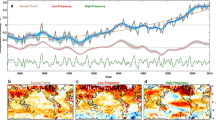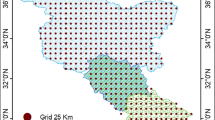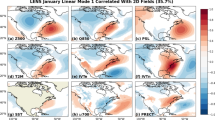Abstract
In analysis of climate variability or change it is often of interest how the spatial structure in modes of variability in two datasets differ from each other, e.g. between past and future climate or between models and observations. Often such analysis is based on Empirical Orthogonal Function (EOF) analysis or other simple indices of large-scale spatial structures. The present analysis lays out a concept on how two datasets of multivariate climate variability can be compared against each other on basis of EOF analysis and how the differences in the multivariate spatial structure between the two datasets can be quantified in terms of explained variance in the leading spatial patterns. It is also illustrated how the patterns of largest differences between the two datasets can be defined and interpreted. We illustrate this method on the basis of several well-defined artificial examples and by comparing our approach with examples of climate change studies from the literature. These literature examples include analysis of changes in the modes of variability under climate change for the sea level pressure (SLP) of the North Atlantic and Europe, the SLP of the Southern Hemisphere, the surface temperature of the Northern Hemisphere, the sea surface temperature of the North Pacific and for precipitation in the tropical Indo-Pacific.














Similar content being viewed by others
References
Bretherton CS, Widmann M, Dymnikov VP, Wallace JM, Bladé I (1999) The effective number of spatial degrees of freedom of a time-varying field. J Clim 12:1990–2009
Chung CTY, Power SB (2012) Nonlinear El Nino rainfall changes under global warming. Submitted to Clim Dyn
Dommenget D (2007) Evaluating EOF modes against a stochastic null hypothesis. Clim Dyn 28:517–531
Dommenget D, Latif M (2002) A cautionary note on the interpretation of EOFs. J Clim 15:216–225
Furtado JC, Di Lorenzo E, Schneider N, Bond NA (2011) North Pacific decadal variability and climate change in the IPCC AR4 models. J Clim 24:3049–3067. doi:10.1175/2010JCLI3584.1
Hu Z, Wu Z (2004) The intensification and shift of the annual North Atlantic Oscillation in a global warming scenario simulation. Tellus A 56A:112–124
Hu Z-Z, Kumar A, Jha B, Huang B (2012) An analysis of forced and internal variability in a warmer climate in CCSM3. J Clim 25:2356–2373
Hurrell JW, Van Loon H (1997) Decadal variations in climate associated with the North Atlantic Oscillation. Clim Change 36:301–326
Jolliffe I (2002) Principal component analysis, 2nd edn. Springer, New York
Keeley SPE, Collins M, Thorpe AJ (2008) Northern hemisphere winter atmospheric climate: modes of natural variability and climate change. Clim Dyn 31:195–211. doi:10.1007/s00382-007-0346-6
Kidston J, Gerber EP (2010) Intermodel variability of the poleward shift of the austral jet stream in the CMIP3 integrations linked to biases in 20th century climatology. Geophys Res Lett 37:1–5. doi:10.1029/2010GL042873
Krzanowski WJ (1979) Between-groups comparison of principal components. J Am Stat Assoc 74:703–707. doi:10.1080/01621459.1979.10481674
Kuzmina SI (2005) The North Atlantic oscillation and greenhouse-gas forcing. Geophys Res Lett 32:1–4. doi:10.1029/2004GL021064
McHugh MJ, Rogers JC (2005) Multi-model representation of the North Atlantic oscillation in the 20th and 21st centuries. Geophys Res Lett 32:1–4. doi:10.1029/2005GL023679
Meehl GA, Covey C, Delworth T, Latif M, McAvaney B, Mitchell JFB, Stouffer RJ, Taylor KE (2007) THE WCRP CMIP3 multimodel dataset: a new era in climate change research. Bull Am Meteorol Soc 88:1383. doi:10.1175/BAMS-88-9-1383
Miller RL, Schmidt GA, Shindell DT (2006) Forced annular variations in the 20th century intergovernmental panel on climate change fourth assessment report models. J Geophys Res 111:1–17. doi:10.1029/2005JD006323
North GR, Bell TL, Cahalan RF (1982) Sampling errors in the estimation of empirical orthogonal functions. Mon Weat Rev 110:699–706
Osborn TJ (2004) Simulating the winter North Atlantic oscillation: the roles of internal variability and greenhouse gas forcing. Clim Dyn 22:605–623. doi:10.1007/s00382-004-0405-1
Petoukhov V, Semenov VA (2010) A link between reduced Barents-Kara sea ice and cold winter extremes over northern continents. J Geophys Res 115:D21111. doi:10.1029/2009JD013568
Rauthe M, Hense A, Paeth H (2004) A model intercomparison study of climate change-signals in extratropical circulation. Int J Climatol 24:643–662
Sengupta S, Boyle JS (1998) Using common principal components for comparing GCM simulations. J Clim 11:816–830. doi:10.1175/1520-0442(1998)011<0816:UCPCFC>2.0.CO;2
Stephenson DB, Pavan V, Collins M, Junge MM, Quadrelli R (2006) North Atlantic Oscillation response to transient greenhouse gas forcing and the impact on European winter climate: a CMIP2 multi-model assessment. Clim Dyn 27:401–420. doi:10.1007/s00382-006-0140-x
Wallace JM, Gutzler DS (1981) Teleconnections in the geopotential height field during the Northern Hemisphere winter. Mon Weat Rev 109:784–812
Acknowledgments
We acknowledge the individual modeling groups, the Climate Model Intercomparison Project (CMIP3). This work was supported by the Deutsche Forschungsgemeinschaft (DFG) through project DO1038/5-1 and the ARC Centre of Excellence in Climate System Science (CE110001028). We thank Jan Harlaß, Klaus Getzlaff, Katja Lorbacher and Gang Wang for discussion and useful comments.
Author information
Authors and Affiliations
Corresponding author
Electronic supplementary material
Below is the link to the electronic supplementary material.
382_2013_1708_MOESM2_ESM.eps
Supplemental Figure S1: Additional experiment for the example in Sect. 5.2, but with two fixed patterns intensified in dataset \(\mathcal{B}\). Part 1: Forcing patterns and difference in variability. Same structure for the figure panels as in Fig. 2: (a)-(b) the two forcing patterns included in \(\mathcal{B}\) (instead of only one as in Sect. 5.2); (c) due to these two forcing patterns, dataset \(\mathcal{B}\) has a higher variability, except in the middle of the domain, where the difference is not significant. (EPS 200 kb)
382_2013_1708_MOESM4_ESM.eps
Supplemental Figure S3: Additional experiment for the example in Sect. 5.3, but with a dipole pattern shift from west (\(\mathcal{A}\)) to east (\(\mathcal{B}\)). Part 1: Forcing pattern and difference in variability. Same structure for the figure panels as in Fig. 2: (a)-(b) the dipole forcing pattern shifts location orthogonal to the line between the two poles, i.e. a shift to the right of 6 grid points in this case; (c)-(d) the difference between the two forcing pattern is a quattro-pole structure, also in the ratio of the standard deviation. (EPS 304 kb)
382_2013_1708_MOESM5_ESM.eps
Supplemental Figure S4: Additional experiment for the example in Sect. 5.3, but with a dipole pattern shift from west (\(\mathcal{A}\)) to east (\(\mathcal{B}\)). Part 2: EOF and DEOF analysis. Same structure for the figure panels as in Fig. 3: (f), (h) as in the example in Sect. 5.3 both DEOF-1 pattern have to be considered together: The DEOF-\(1^{{\mathcal{A} \to \mathcal{B}}}\) shows where the EOF-2 pattern has weakened and the DEOF-\(1^{{\mathcal{B} \to \mathcal{A}}}\) where the EOF-2 pattern has strengthened, thus showing both together the shift in the EOF-2 pattern. The centers of the dipoles in the DEOF patterns agree with the regions of strongest increase/decrease in variability, as seen in Fig. S3d, i.e. the DEOF analysis reveals how the changes in variability relate to the changes in the modes of variability. (EPS 300 kb)
382_2013_1708_MOESM6_ESM.eps
Supplemental Figure S5: Additional experiment for the example in Sect. 5.3., but with a dipole pattern shift from south (\(\mathcal{A}\)) to north (\(\mathcal{B}\)). Part 1: Forcing pattern and difference in variability. Same structure for the figure panels as in Fig. 2: (a)-(b) the forcing pattern shifts along the line between the two centers, i.e. an upward shift of 1 grid point in this case. (c)-(d) absolute difference in the forcing is a quattro-pole structure, also in the ratio of the standard deviation. (EPS 267 kb)
382_2013_1708_MOESM7_ESM.eps
Supplemental Figure S6: Additional experiment for the example in Sect. 5.3., but with a dipole pattern shift from south (\(\mathcal{A}\)) to north (\(\mathcal{B}\)). Part 2: EOF and DEOF analysis. Same structure for the figure panels as in Fig. 3: (a)-(d) here we choose a quite strong forcing, so that the EOF-1 is a dipole and EOF-2 is a monopole. A small upward shift of the pattern can be seen, if we look closely on the EOF-1 patterns of \(\mathcal{A}\) and \(\mathcal{B}\); (e), (g) the projected explained variances show no difference in explained variance of the EOF pattern, due to high pattern correlation between the EOF patterns of the two datasets (0.99 for the EOF-1 and 1.00 for the EOF-2). (f), (h) the two centers of both DEOF pattern are exactly at the points where the variability changes strongest. The two DEOF-1 patterns show together the northward shift of the two poles in the EOF-1. In comparison with the example in Figure S4 we can see that the small shift of 1 grid point along the line between the two centers gives nearly the same difference in the DEOF pattern than a 6 grid point shift orthogonal to the line between the two centers. (EPS 309 kb)
Rights and permissions
About this article
Cite this article
Bayr, T., Dommenget, D. Comparing the spatial structure of variability in two datasets against each other on the basis of EOF-modes. Clim Dyn 42, 1631–1648 (2014). https://doi.org/10.1007/s00382-013-1708-x
Received:
Accepted:
Published:
Issue Date:
DOI: https://doi.org/10.1007/s00382-013-1708-x




